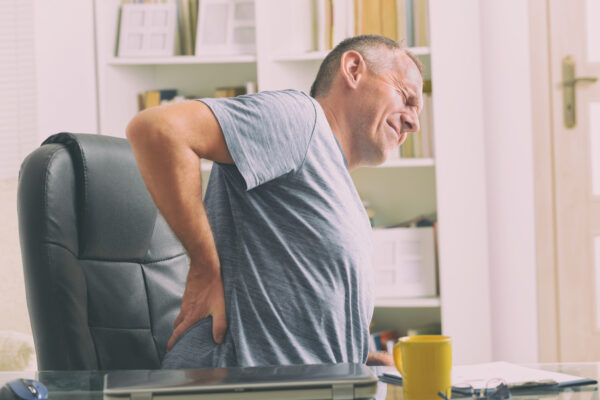Living with osteoarthritis of the knee is not easy, but you can do things to help manage your symptoms. Although osteoarthritis can’t be cured, learning how to care for your body with this condition can alleviate some pain and discomfort.
If you’re suffering from osteoarthritis, our experienced team of physiotherapists at Guy’s and St Thomas’ Specialist Care will work with you to create a tailored treatment plan – helping you get back to your normal activities fast. Speak to our physiotherapy team today.
This article will look into osteoarthritis, what causes it and what you can do to manage your condition effectively.
What is osteoarthritis of the knee?
Osteoarthritis is a common condition that causes your joints to become painful and stiff. It’s a type of arthritis that develops over time and occurs when the cartilage in your joints wears down. The wear can then lead to pain, swelling and decreased mobility.
Your knee joint consists of the femur (thigh bone), tibia (shin bone) and patella (kneecap). Osteoarthritis can affect any part of your knee joint, including the cartilage covering the ends of your bones — making it hard to move the joint.
What causes osteoarthritis?
There are many potential causes of osteoarthritis, including:
- age – one of the most common causes of osteoarthritis as your joints become less flexible and more prone to damage as you get older.
- gender – women are more likely to develop the condition, and it’s thought to be due to the change in hormones after menopause.
- obesity – being overweight puts extra stress on your knee joint, which can lead to osteoarthritis.
- injuries – damage to the knee joint from ligament tears or fractures can increase the risk of developing osteoarthritis, especially if it isn’t treated or doesn’t heal properly.
- genetics – some people are genetically predisposed to develop osteoarthritis.
- repetitive stress – jobs or activities that put repeated stress on the knees can increase the risk of osteoarthritis.
- medical conditions – certain conditions, such as rheumatoid arthritis, gout and diabetes, can increase your risk of developing the condition.
Osteoarthritis knee symptoms
Symptoms of osteoarthritis in the knee can include:
- pain – most commonly, people experience a sharp or dull pain that ranges from mild to severe.
- stiffness – your knee joint can feel as though it is ‘locking up’, especially after long periods of inactivity.
- swelling – your knee joint can become swollen and inflamed clicking – some people hear popping or clicking sounds when they move their knees.
- reduced range of motion – it can become increasingly difficult for you to bend or straighten your knee.
- deformities – in severe cases, changes in the cartilage and bone can cause your knee joint to become misshapen.
Living with osteoarthritis of the knee
Having osteoarthritis of the knee does not mean you can’t lead a healthy, active life. You can make changes to your lifestyle that could help alleviate your symptoms. For example, maintaining a healthy weight can help to reduce osteoarthritis symptoms as it decreases the amount of pressure on your joints.
Regular exercise can also help you to maintain your weight and strengthen the muscles around your knee joint, which can lead to improved flexibility and better pain management.
Low-impact exercises like swimming, cycling and walking are good options as they don’t put too much strain on your knees.
Diet and osteoarthritis
Following a healthy diet can help you to manage some osteoarthritis symptoms by reducing inflammation, as well as helping you to maintain a healthy weight and reduce stress on your affected knee joint.
A good diet for osteoarthritis includes many nutrient-dense foods, such as fruits, vegetables, whole grains, lean proteins and healthy fats. In addition, foods high in omega-3 fatty acids (like oily fish) have anti-inflammatory properties and could help reduce inflammation in the knee joint.
Dark leafy greens like spinach and kale are high in antioxidants, which can help reduce inflammation.
If you have osteoarthritis, it’s essential to try and avoid or limit your intake of foods that contribute to inflammation. These foods include refined sugars, saturated and trans fats and excessive amounts of red meat. Try to keep your alcohol intake to a minimum as well.

Dark leafy greens, such as spinach and kale, can help reduce inflammation
Exercise and osteoarthritis
Knee exercises are a great way to improve joint strength, flexibility and range of motion. They can help relieve pain and stiffness, too.
Our physiotherapy team work closely with you to develop an individualised treatment plan based on your specific needs and goals. Get in touch with our friendly team to discuss your needs today.
Here are some knee exercises and stretches for osteoarthritis:
- straight leg raises – lie on your back with one leg straight and the other bent. Slowly lift the straight leg to about hip level, hold for a few seconds, and then slowly lower it back down. Repeat on the other leg.
- hamstring curls – stand behind a chair or counter for support and slowly bend one knee, bringing your heel towards your buttocks. Then slowly lower it back down. Repeat on the other leg.
- quadricep contractions – sit with your legs straight out in front of you. Tighten the muscles in the front of your thigh on one leg, hold for a few seconds, and then relax. Repeat on the other leg.
- wall squats – stand with your back against a wall and your feet shoulder-width apart. Slowly slide down the wall into a squat position, holding for a few seconds, then slowly rise back up.
- calf raises – stand with your feet shoulder-width apart and rise onto your tiptoes. Hold this for a few seconds, then slowly lower back down.
- seated knee extensions – sit in a chair with your feet flat. Slowly straighten one leg out before you, then slowly bring it back to the starting position. Repeat with the other leg.
Make sure you gradually increase intensity as your joint grows stronger. Always listen to your body and stop any exercise that causes you pain.
Treatment options for knee osteoarthritis
Many different treatments can help you manage and improve your knee osteoarthritis. The type of treatment will depend on the severity of your condition and your specific needs.
Physiotherapy for knee osteoarthritis
Physiotherapy is a vital part of the treatment plan for knee osteoarthritis. Physiotherapy can help reduce pain, improve mobility and enhance the overall function of your knee.
A physiotherapist can work with you to develop a tailored exercise programme for your individual needs, goals and fitness level.
Experts use several types of physiotherapy to treat osteoarthritis, including hydrotherapy, manual therapy and therapeutic exercise.
Hydrotherapy involves exercising in a warm pool of water, which can reduce joint pain and stiffness while providing support and buoyancy to the body. Manual therapy involves hands-on techniques such as massage and joint mobilisation, which can help improve joint function and range of motion. The therapeutic exercise involves various exercises and stretches designed to improve strength, flexibility and balance.
Knee support for osteoarthritis
Knee braces and knee supports can help manage osteoarthritis symptoms, including pain and reduced mobility. They also provide additional support and stability to your knee joint, which can help reduce stress and pressure.
Various knee braces and supports are available, including those specifically designed for osteoarthritis. Unloader braces, for example, shift weight away from the affected knee joint area, which can help reduce pain and improve mobility.
Compression sleeves and wraparound braces can also provide additional support and reduce swelling and inflammation.
Other types of support include canes or crutches, which can help reduce weight-bearing on your affected knee joint. A medical expert may also recommend shoe inserts or orthotics to help improve foot and ankle alignment.
Pain relief medicine
Our pain specialists can suggest several medicines to help manage your symptoms of osteoarthritis, including paracetamol, non-steroidal anti-inflammatory drugs (NSAIDs) and steroid injections.
Paracetamol, which you can buy over the counter, can reduce mild to moderate pain but you should not take it in higher doses than recommended.
NSAIDs are another type of pain relief medication that can help reduce joint pain, swelling and stiffness. You can buy some NSAIDs, such as ibuprofen, over the counter, while others require a prescription. However, NSAIDs can have side effects including stomach irritation, so it’s important to take them only as directed.
Steroid injections are a treatment that can be used to reduce inflammation and pain in a specific joint. When injected directly into the joint, they can relieve symptoms. However, steroid injections are usually reserved for more severe cases of osteoarthritis, and only medical professionals give them.
Osteoarthritis knee surgery
Knee replacement surgery is a procedure used to replace damaged or worn parts of the knee with an artificial joint. Knee replacement surgery aims to reduce pain and improve mobility and function.
During the procedure, the surgeons will make an incision in the knee and remove the damaged portions of the joint, including the cartilage and bone. They then implant the artificial joint in the knee. It will replicate the function and movement of a natural knee joint.
Surgeons only offer knee replacement surgery to people with severe knee pain and functional limitations caused by osteoarthritis.
Book an appointment
At Guy’s and St Thomas’ Specialist Care, we offer a wide range of physiotherapy services, including musculoskeletal assessments, extracorporeal shockwave therapy (ESWT) and sports injury rehabilitation. Our facilities include private treatment rooms and rehabilitation gymnasiums. Our team of expert medical professionals use the latest techniques and equipment to provide you with the highest level of care and support.
Our pain medicine services and rheumatology services also offer management and treatment of musculoskeletal and joint pain.
If you’re suffering from osteoarthritis, our experienced team of professionals will work with you to provide the best possible treatment to help you get back to your normal activities fast. Book an appointment today.


